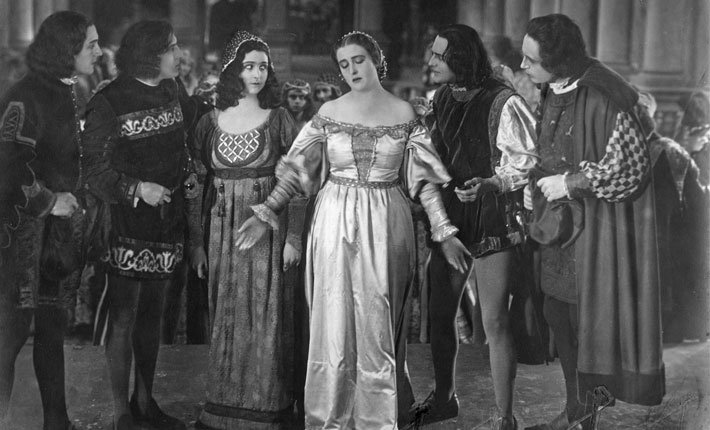Shakespeare on the Silent Screen: The Merchant of Venice (Der Kaufmann von Venedig)
The Merchant of Venice (Der Kaufmann von Venedig) + live accompaniment by Stephen Horne
Sunday 10 April 2016
Barbican Cinemas
Review by Richard Foord, MA Renaissance Literature

Shakespeare on the Silent Screen: The Merchant of Venice (Der Kaufmann von Venedig). Image: Barbican
Peter Paul Felner’s Der Kaufmann von Venedig begins with the reassuring statement that the plot of Shakespeare’s play has been “Slightly modified in order to not offend the modern standard of good taste.” This supplication drew a murmured chuckle from the assembled Barbican crowd who, perhaps unlike the film’s original 1920s audience, were by now well accustomed to the twisting and contorting of Shakespeare’s plays into dramatically altered forms.
As with many modern showings of old films, there is a need for an audience to gradually re-orientate their expectations towards the aesthetic formulae of silent cinema. The first part of the film had a succession of moments in which the film’s highly wrought sincerity – both in the captions and its flamboyantly expressive acting, drew condescending laughs from the audience; for example, Porzia’s exaggerated and wide-eyed laments at her treatment by her father.
However, one facet of the film that facilitated a re-orientation of the audience’s expectations was the performance of Werner Krauss as Shylock. Krauss played the title character with a brooding darkness in his unblinking eyes, and an economy of movement and expression that separated him from those around him; increasing the sense of his isolation and marginalisation. The cinematography particularly enhanced this performance, with Felner punctuating the piece with a succession of extreme close-ups of Krauss’ lined and tormented face.
A further aspect of the event which ensured its ultimate success was Stephen Horne’s accompaniment. He was surrounded by instruments, utilising at different points flute, accordion, and percussion. This multi-instrumentation was particularly successful in its use of different motifs and instruments for different characters and scenarios. For example, tender scenes between Porzia and Bassanio was accompanied by soft flowing flute, giving the on screen expression an aural correlative that heightened the emotional pitch of the scene. Horne also used the piano in innovative ways, directly tapping and plucking the piano strings to achieve a distinctive tone.

